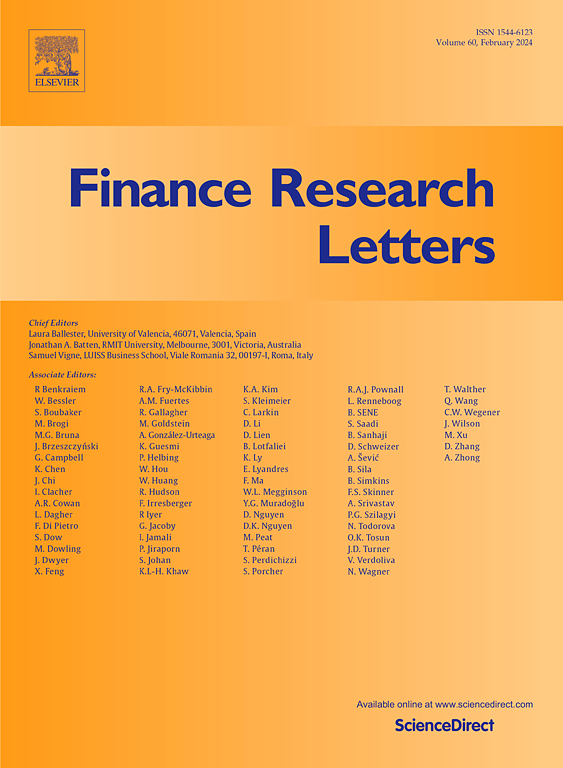总销售、一般和管理费用信号对市场回报的影响
IF 6.9
2区 经济学
Q1 BUSINESS, FINANCE
引用次数: 0
摘要
本文研究了总销售、一般和管理费用(以下简称SG&;A)信号对未来市场回报的影响。我们将总SG&;A信号定义为两个期间总SG&;A成本比率(即,SG&;A与销售额的比率)的正变化。以1975年至2019年的美国上市公司为样本,并对总体水平回归模型进行估计,我们发现,在控制了总收益和其他相关变量后,在SG&; a信号可用的季度之后的三个季度内,总SG&; a信号与市场回报呈正相关。这种积极的联系在总销售额下降的季度比销售额增长的季度更为明显。这些结果表明,市场并没有完全领会总成本行为对股票收益的影响。此外,我们发现总SG&;A信号与市场回报之间的这种正相关部分是由总SG&;A信号中嵌入的现金流影响和贴现率新闻驱动的。另外的测试表明,在大公司、周期性行业、1990年后时期、扩张期间以及包括更多控制措施时,总SG&;A信号与未来回报之间的总体关联更为明显。这些结果为现金流和贴现率新闻的机制提供了进一步的证据。总体而言,我们的研究强调了总成本行为对资本市场预测的增量贡献。本文章由计算机程序翻译,如有差异,请以英文原文为准。
Implications of aggregate selling, general, and administrative expense signals on market returns
This paper investigates the implications of aggregate selling, general, and administrative expense (hereafter, SG&A) signals on future market returns. We define aggregate SG&A signals as positive changes in the aggregate SG&A cost ratio (i.e., the ratio of SG&A to sales) between two periods. Using U.S. public firms from 1975 to 2019 as a sample and estimating the aggregate-level regression models, we find that aggregate SG&A signals are positively associated with market returns in up to three quarters following the quarter in which the SG&A signals become available after controlling for aggregate earnings and other relevant variables. This positive association is more pronounced in quarters of aggregate sales decreases than sales increases. These results suggest that the market is not fully impounding the stock return implications of aggregate cost behaviors. Furthermore, we find that this positive association between aggregate SG&A signals and market returns is partially driven by the cash flow implications and discount rate news embedded in aggregate SG&A signals. Additional tests demonstrate that the overall association between aggregate SG&A signals and future returns is more pronounced in large firms, in cyclical industries, during the post-1990 period, during expansions, and when more controls are included. These results provide further credence to the mechanisms of cash flow and discount rate news. Overall, our study highlights the incremental contribution of aggregate-level cost behaviors to capital market prediction.
求助全文
通过发布文献求助,成功后即可免费获取论文全文。
去求助
来源期刊

Finance Research Letters
BUSINESS, FINANCE-
CiteScore
11.10
自引率
14.40%
发文量
863
期刊介绍:
Finance Research Letters welcomes submissions across all areas of finance, aiming for rapid publication of significant new findings. The journal particularly encourages papers that provide insight into the replicability of established results, examine the cross-national applicability of previous findings, challenge existing methodologies, or demonstrate methodological contingencies.
Papers are invited in the following areas:
Actuarial studies
Alternative investments
Asset Pricing
Bankruptcy and liquidation
Banks and other Depository Institutions
Behavioral and experimental finance
Bibliometric and Scientometric studies of finance
Capital budgeting and corporate investment
Capital markets and accounting
Capital structure and payout policy
Commodities
Contagion, crises and interdependence
Corporate governance
Credit and fixed income markets and instruments
Derivatives
Emerging markets
Energy Finance and Energy Markets
Financial Econometrics
Financial History
Financial intermediation and money markets
Financial markets and marketplaces
Financial Mathematics and Econophysics
Financial Regulation and Law
Forecasting
Frontier market studies
International Finance
Market efficiency, event studies
Mergers, acquisitions and the market for corporate control
Micro Finance Institutions
Microstructure
Non-bank Financial Institutions
Personal Finance
Portfolio choice and investing
Real estate finance and investing
Risk
SME, Family and Entrepreneurial Finance
 求助内容:
求助内容: 应助结果提醒方式:
应助结果提醒方式:


